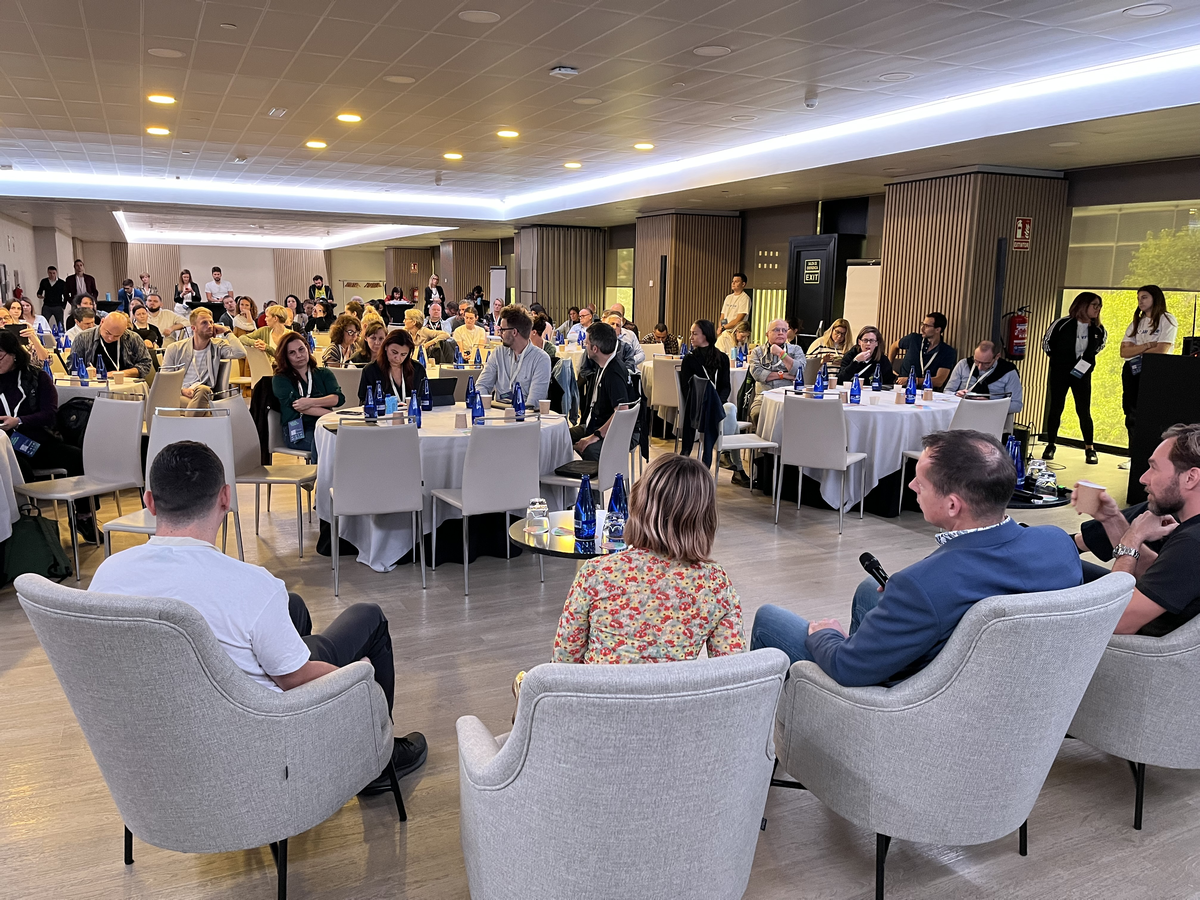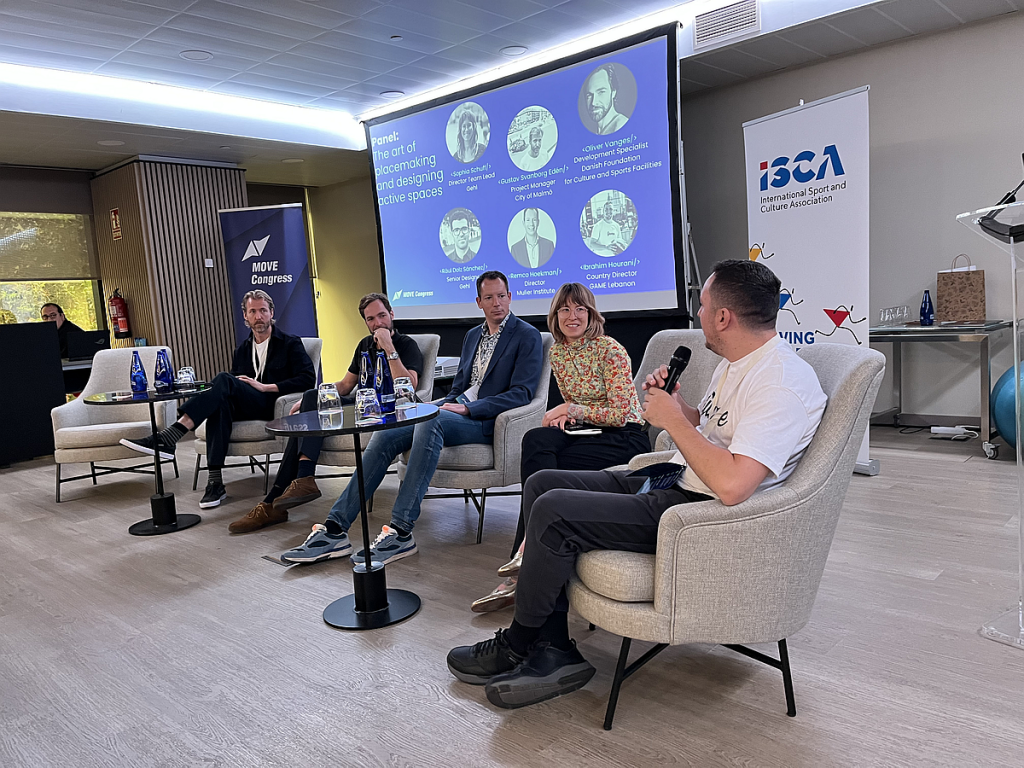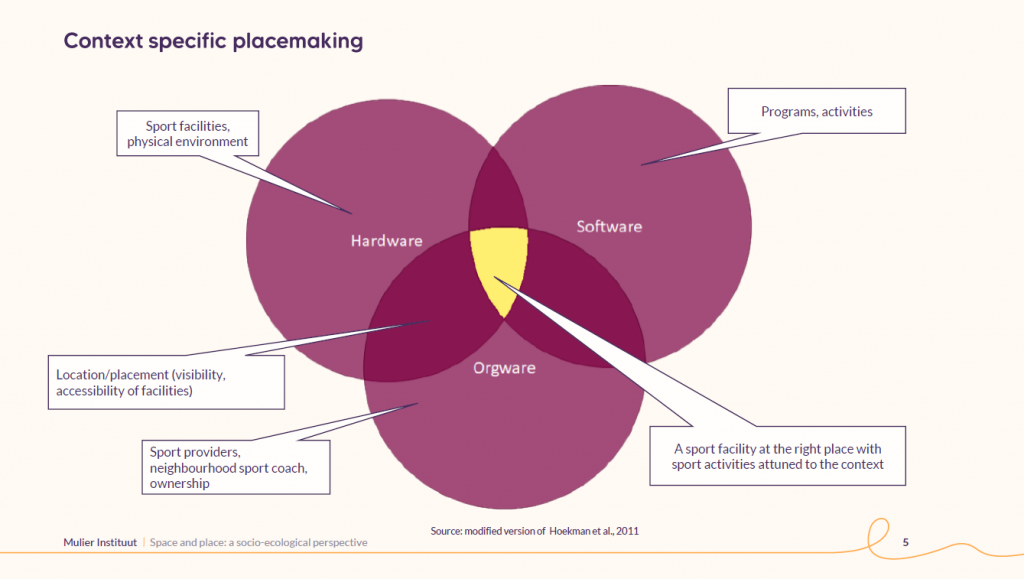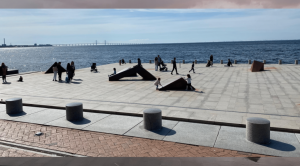
Eight golden rules from experts in placemaking and repurposing facilities for active lifestyles
Placemaking is an art. It is design. And it is integral to how we experience the spaces in which we move around every day. The MOVE Congress dedicated a full track on 17 November to exploring what placemaking is and how it can help cities to create attractive, safe and active public “rooms”. Urban design experts Sophia Schuff and Raúl Dolz Sánchez from Gehl in Denmark and Spain led the two-part session ‘The art of placemaking and designing active spaces’, featuring mini-keynotes, a panel discussion and an interactive workshop.
The parallel session introduced the five panellists to a full house of sport and physical activity promoters who work in public spaces and with municipalities – or are curious to know how. Eight ‘golden rules’ stood out from the valuable know-how shared by Schuff, Ibrahim Hourani, GAME Lebanon; Remco Hoekman, Mulier Institute and Radboud University, the Netherlands; Gustav Svanborg Edén, City of Malmö, Sweden; and Oliver Vanges, the Danish Foundation for Culture and Sports Facilities/LOA, Denmark.

Think of ‘hardware’, ‘orgware’ and ‘software’ as the Holy Trinity of Placemaking
Remco Hoekman has long advocated that ‘hardware’ (the physical facilities or spaces), ‘orgware’ (the people, organisations and/or political actors governing the space), and ‘software’ (the activities taking place in the space) are the Holy Trinity of urban design. All three elements must be present to make an idea come to life.
While we often think of what (the software) to do where (the hardware), we tend to forget who (the orgware) is important to motivate and include in the process. A strong vision and backing from a government or municipality, for example, can be a critical piece of the puzzle, as Oliver Vanges points out.
“Municipalities are way too modest and way too invisible in what they want to do with their city and their spaces. There’s an arm’s length principle that can turn into a fear of not touching anything. While arm’s length is fine, you need to be clear that what you want is an active city and make that statement.”

Capture the needs of the target group by observing them
“They don’t know” and “you don’t know, either” might seem like strange confessions to make when embarking on a placemaking project, but this was the message that echoed from speaker to speaker. Don’t assume that you understand what your target group wants or needs. And you might not find out by asking them, either. You need to observe them and work with what you discover.
As an urban designer, this can mean nudging politicians to explore the space for themselves, as Sophia Schuff explains. “Our job is to bring policy makers at eye level, get them onto streets and talking to communities. Observational data collection can be a great tool to say, hey, go out and observe people and report back what you find. Often we find that many of the policy makers we work with have never been into the community they are working to design.”
From the sport NGO’s perspective, it can mean inviting the target group into the place to try out different activities, as Ibrahim Hourani illustrates. “What we did in Lebanon is that we created stations in the space that was not built yet, so we put up a moveable basketball hoop, some stuff for parkour, some ramps for skateboarding and then we held a playing day for them where we invited them to go to the different stations and then rate the stations. By their rating we figured out that they liked parkour, even though they didn’t know what it is. They liked skateboarding even though they’d never skated before. So this is how we took their ideas.”
Don’t limit your ideas to “sport” – let people play
 Even though this MOVE Congress track was born out of an EU-supported project called Placemaking and Sport and the expert panellists specialise in sports facilities and programmes, they encouraged the audience to think of more than ‘sport’ when (re)designing public spaces for people to be active. “[Try to make them] less ‘sports-coded’ and more of an invitation,” Oliver Vanges said.
Even though this MOVE Congress track was born out of an EU-supported project called Placemaking and Sport and the expert panellists specialise in sports facilities and programmes, they encouraged the audience to think of more than ‘sport’ when (re)designing public spaces for people to be active. “[Try to make them] less ‘sports-coded’ and more of an invitation,” Oliver Vanges said.Gustav Svanborg Edén gave the example of the Malmö skate sculptures built by the sea, which, despite being built for skateboarding, are so ambiguous in form that they have become a climbing and sliding magnet for children as well.
Avoid cut-and-paste approaches – always customise
Ibrahim Hourani discovered from experience that you can’t cut a GAME street sport facility design directly from Denmark and paste it in Lebanon. And Oliver Vanges notes that there is an abundance of placemaking toolkits out there, but you can’t expect communities around the world to be able to apply these directly to their own contexts. Understanding the space, context and community is key to customisation, and this links back to understanding the target group.
Repurpose rather than build
“The best new sports facilities are the ones that never get built,” Vanges once said as a show-stopping introduction to an international sports conference presentation. He and Gustav Svanborg Edén reiterated this point in Madrid by showing the funkiest examples from Denmark (a rooftop functional training facility above a parking tower) and Sweden (an old brewery in Malmö). Don’t build a brand new facility for the sake of it – seek out disused buildings or spaces and use your imagination to repurpose them. Can old industrial buildings become new sports facilities? Or can you pitch your idea for a facility “as an add-on to an existing infrastructure project,” Svanborg Edén asks?
Respect the public and share the space
But, of course, repurposing existing infrastructure, particularly in cities or residential areas, may not be a popular decision if it threatens to disturb the peace, as Svanborg Edén has found whilst creating places for skateboarders in Sweden. He says it is important not to address public concerns openly and make sure residents can share the space comfortably with the target group. “Why are they [the residents] complaining? It’s probably because they’re feeling disenfranchised from the process. They feel that someone is coming into their neighbourhood and they’re scared of it. So there are different ways to approach that.”
Give your target group a reason to stay in the place
Multi-functional places can be an effective way to welcome a broad range of community members into a public space. But it can be tempting to try to cater for too many people, which can ultimately deter them from the place if it becomes too messy or chaotic.
That’s why Gehl likes to play with the notion “Can we make a place sticky?” to test their ideas and find out if they are successful. Sophia tells, “we measure the amount of time people stay in a place before and after the intervention.”
Money doesn’t necessarily create the best places
“It’s not about the money; it’s about paying attention to the first phase of the design,” Oliver Vanges says, showing pictures of expensive (and empty) projects. “Things don’t happen on their own, even if you throw lots of money at it.”
Remco Hoekman agrees that money should not be the main driver or end goal for a placemaking project. And that success should be measured by the social impact it achieves.
“I think most of the effect is on the social aspects – bringing people together and the cohesion of society taking ownership of their own environment,” he says. “And that’s hard to put a monetary value on. But if you go to politicians, basically that is why they exist, because they are there for society and this is what they should embrace. It’s difficult to monetarise because it’s far better than money, and that should be the message to politicians.”
This MOVE Congress track is part of a two-year project led by the International Sport and Culture Association (ISCA). Find out more about the project here


